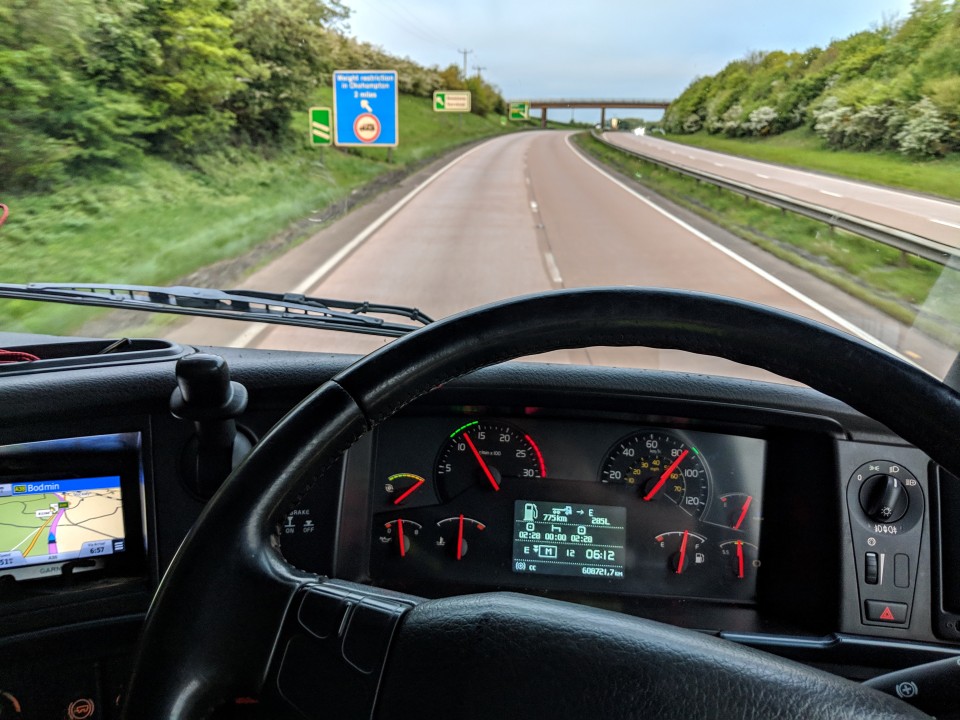
Susie Jones
A tachográfokra vonatkozó szabályok megkönnyítve
Létrehozva: 01. 08. 2024
•
Frissítve: 08. 08. 2024
A menetíró készülékekre vonatkozó szabályok világa még a legtapasztaltabb tehergépkocsi-vezető számára is zavarba ejtő lehet. Nem is beszélve azokról, akik újonnan lépnek be az ágazatba. Célunk, hogy tisztázzuk ezt a zűrzavart.
Mi az a tachográf és miért van tachográf?
A szótár szerint a tachográf "olyan eszköz, amelyet a járművekben, például teherautókban és autóbuszokban helyeznek el, hogy rögzítse az olyan információkat, mint például a jármű sebessége, a megtett út hossza és a vezető által tartott szünetek száma".
A tachográf célja a járművezetők fáradtságának megelőzése, valamint annak biztosítása, hogy a járművezetők és a munkáltatók betartsák a szabályokat. A [Brake közúti közlekedésbiztonsági jótékonysági szervezet] (https://www.brake.org.uk/get-involved/take-action/mybrake/knowledge-centre/driver-fatigue) arról számolt be, hogy "tízből négy fáradtsággal összefüggő balesetben olyan személy vesz részt, aki haszongépjárművet vezet". Ezért a menetíró készülékekre vonatkozó szabályok létfontosságú szerepet játszanak abban, hogy ezt a számot csökkentsék.
Mikor van szükség tachográfra?
Akkor kell tachográfot felszerelnie, ha a jármű össztömege meghaladja a három és fél tonnát. Fontos megjegyezni, hogy ebbe beletartozik a pótkocsi vontatása is. Ez alól a szabály alól van néhány kivétel:
Ha csak közutakon kívül vezet
Ha a járművet fegyveres erők, rendőrök vagy tűzoltók vezetik
Ha Ön egy kereskedelmi flotta, és legfeljebb hét és fél tonnás járműveket használ, és az útvonal kevesebb mint 100 km távolságra van az üzemi bázisától.
Ha Ön árut szállít, és járműve elektromos meghajtású
Ha a járművezető használatára szolgáló felszerelést vagy gépet szállít, és a jármű vezetése nem az Ön fő munkája.
Melyek a tachográfok különböző típusai?
A tachográfoknak három különböző típusa létezik:
Analóg: Ezeket 1986-ban tették kötelezővé Európában. Az analóg tachográfok viaszpapírlapokat használnak a járművezető adatainak rögzítésére. A járművezetők manuálisan írják be az adatokat, és helyezik be őket a tachográf készülékbe.
Digitális: Ezek 2006-ban kerültek bevezetésre. Több mint egymillió fuvarozó cég és több mint hatmillió hivatásos járművezető használja. A digitális tachográfok belső tárolóeszközön és járművezetői kártyán rögzítik a járművezető adatait.
Okos: 2019 júniusától az Európai Unió előírta a vállalatok számára az intelligens tachográfok használatát. Ezek automatikusan rögzítik a jármű helyét minden egyes út elején és végén. Emellett háromóránként frissítéseket is szolgáltatnak.
Mit jelentenek az egyes tachográf szimbólumok?
Nézze meg videónkat, amely elmagyarázza az egyes tachográf szimbólumokat.
Szabályok megszegése
A tehergépkocsivezető és az úton közlekedők biztonsága érdekében a szüneteltetési szabályokat be kell tartani. A legfontosabb pontokat bontottuk le.
Vezetési idő:
- Nem lehet hosszabb négy és fél óránál szünet előtt.
Szünetek:
- Legalább 45 percnek kell lennie, kivéve, ha a járművezető pihenőidőt tart.
Pihenőidő:
- A pihenőidő alatt nem lehet vezetni vagy más munkát végezni.
Szünetek felosztása:
Egy teljes 45 perces szünetet fel lehet osztani egy 15 perces szünettel, amelyet egy 30 perces követhet.
A szüneteket a négy és fél órás vezetési időre kell elosztani.
Az uniós szabályok szerint, ha a szüneteket megosztják, a második szünetnek legalább 30 percesnek kell lennie.

Napi vezetési limit
A napi vezetési limit a napi maximális vezetési időre vonatkozik. Kilenc óra a maximum, de ez 10 órára növelhető. Ez azonban egy meghatározott héten belül legfeljebb kétszer tehető meg. A napi vezetési idő a következőképpen határozható meg:
A napi pihenőidő vége és a következő napi pihenőidő kezdete közötti teljes felhalmozott vezetési idő.
A napi pihenőidő és a heti pihenőidő közötti teljes felhalmozott vezetési idő. .
Heti és kétheti vezetési korlátozás
A járművezetőknek ügyelniük kell arra, hogy ne lépjék túl a heti és kétheti maximális vezetési limitet.
A maximális heti vezetési idő 56 óra (rögzített hétre vonatkozik).
A rögzített hét 00.00 órakor kezdődik és a következő vasárnap 24.00 órakor ér véget.
A kétheti vezetési idő 90 óra.
Napi pihenés
Ezenkívül napi pihenőidőt kell tartani.
A járművezetőnek 11 óra folyamatos pihenőidőt kell tartania. Ez kilencre csökkenthető
Ez a csökkentés legfeljebb háromszor fordulhat elő a heti pihenőidők között.
A pihenőidőt az utolsó napi vagy heti pihenőidő végétől számított 24 órán belül be kell tölteni.
A napi pihenés a járműben is lehetséges, azonban megfelelő alvási lehetőség szükséges. Ha ezek a létesítmények hiányoznak, a járművezetőnek kell szállást találnia. Nézze meg a helyszínek oldalunkat, hogy megtudja, mely kamionmegállók kínálják ezt a szolgáltatást.
Heti pihenő
A heti pihenőidőt legkésőbb az utolsó heti pihenőidő végétől számított hat egymást követő 24 órás időszak végén kell kivenni.
A járművezetőknek legalább 45 óra pihenőidőt kell tartaniuk.
Legalább 24 órás csökkentett heti pihenőidőt tarthatnak.
A csökkentett heti pihenőidőt egy blokkban kell pótolni, és legalább kilenc órával a harmadik hét vége előtt.
Bár csökkentett pihenőidő is kivehető, érdemes megjegyezni, hogy két egymást követő héten, amikor csökkentett pihenőidőben dolgoznak, az egyiknek 45 órásnak kell lennie.

Többfős személyzet
Egyes járművezetők egy másik járművezetőt is felvehetnek a fedélzetre. Ennek előnyei közé tartozik a nagyobb termelékenység, a nagyobb megtett kilométerek és a hosszabb vezetési idő.
Mindkét járművezetőnek napi kilenc óra pihenőidőt kell tartania
Ezt a napi pihenőidőt nem 24, hanem 30 órán belül kell kivenni.
Az első órában a multi-manning nem igényel másik járművezetőt. Egy óra elteltével kötelezővé válik.
Kompátkelés vagy vonatozás
A fentiek szerint a járművezetők rendszeres napi pihenőidejének 11 óra folyamatos pihenőidőnek kell lennie, ez alól azonban van néhány kivétel. Feltéve, hogy a járművet a járművezető kíséri; a napi pihenőidő kétszer megszakítható, de nem haladhatja meg az egy órát összesen. Például kompokra és vonatokra való fel- és leszálláskor.
Ha a rendszeres napi pihenőidő ily módon megszakad, az összesített pihenőidőnek legalább 11 órának, illetve osztott pihenőidő esetén 12 órának kell lennie.
Mi az egyperces tachográf szabály?
Az egyperces szabály 2011 októberében lépett hatályba. Ez a régebbi jogszabályra utal, amely részletezte, hogy minden olyan percet, amely legalább öt másodpercnyi vezetési időt tartalmaz, vezetési időnek kell tekinteni. Az EU azonban megváltoztatta ezt a jogszabályt, így az egy percen belül végzett leghosszabb folyamatos tevékenységet az adott tevékenységgel szemben kell naplózni.
Mi történik, ha nem tartom be a tachográf szabályait?
A menetíró készülékekre vonatkozó szabályok be nem tartása pénzbírsággal, esetenként börtönbüntetéssel járhat. A büntetés általában a jogsértés súlyosságától függ. A legtöbb tachográf-szabálysértést fix összegű büntetéssel kezelik. A járművezetőknek legfeljebb 28 napjuk van a fix bírságok megfontolására.
Az Egyesült Királyságban kétféle bírság és büntetés létezik.
Negyedik szintű bírság: Ezek felső határa 2500 font; ez a felső határ minden egyes tachóbírságra vonatkozik. A többszörös négyes szintű jogsértés esetén azonban jogsértésenként maximális bírsággal lehet számolni.
Ötödik szintű bírság: Ezek felső határa 5000 font, azonban a négyes szintű bírságokhoz hasonlóan a többszörös jogsértések esetén a maximális bírsággal kell számolni.
A menetíró készülékekre vonatkozó szabályokat nem könnyű átlátni. A szabályok be nem tartása azonban biztonsági problémákhoz és potenciális bírságokhoz vezethet. A szabályok megértésével és betartásával a flották és a járművezetők biztonságosan és jogszerűen üzemeltethetik járműveiket. Fontos megjegyezni, hogy a tachográf szabályai és előírásai országonként eltérőek lehetnek.



